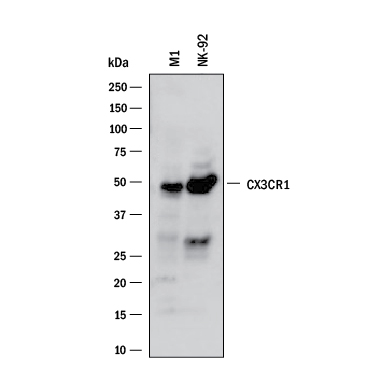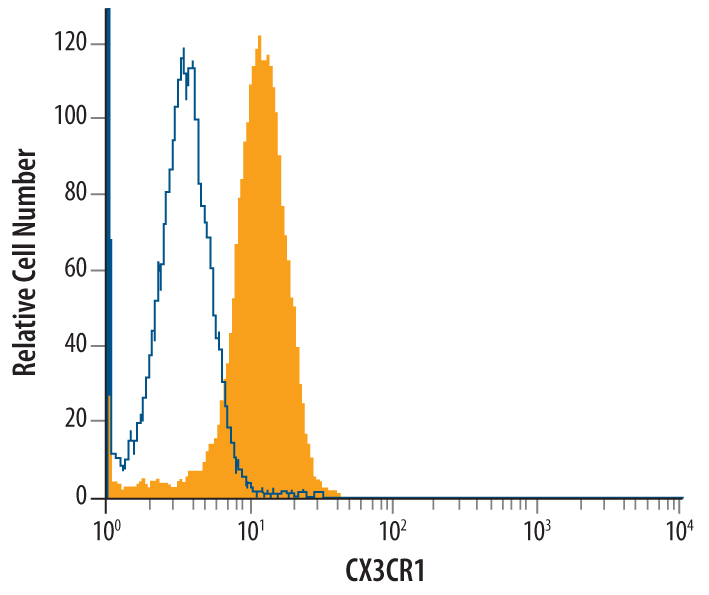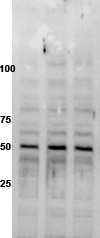Human/Mouse CX3CR1 Antibody Summary
Met1-Thr32, Leu92-Lys104, Thr169-Val196, Lys258-Leu274
Accession # Q9Z0D9
Applications
Please Note: Optimal dilutions should be determined by each laboratory for each application. General Protocols are available in the Technical Information section on our website.
Scientific Data
 View Larger
View Larger
Detection of Human and Mouse CX3CR1 by Western Blot. Western blot shows lysates of M1 mouse myeloid leukemia cell line and NK-92 human natural killer lymphoma cell line. PVDF membrane was probed with 1 µg/mL of Human/Mouse CX3CR1 Antigen Affinity-purified Polyclonal Antibody (Catalog # AF5825) followed by HRP-conjugated Anti-Goat IgG Secondary Antibody (Catalog # HAF109). A specific band was detected for CX3CR1 at approximately 50 kDa (as indicated). This experiment was conducted under reducing conditions and using Immunoblot Buffer Group 1.
 View Larger
View Larger
Detection of CX3CR1 in M1 Mouse Cell Line by Flow Cytometry. M1 mouse myeloid leukemia cell line was stained with Human/Mouse CX3CR1 Antigen Affinity-purified Polyclonal Antibody (Catalog # AF5825, filled histogram) or isotype control antibody (Catalog # AB-108-C, open histogram), followed by Phycoerythrin-conjugated Anti-Goat IgG Secondary Antibody (Catalog # F0107).
Reconstitution Calculator
Preparation and Storage
- 12 months from date of receipt, -20 to -70 °C as supplied.
- 1 month, 2 to 8 °C under sterile conditions after reconstitution.
- 6 months, -20 to -70 °C under sterile conditions after reconstitution.
Background: CX3CR1
CX3CR1 (CX3C chemokine receptor 1; also fractalkine receptor, GPCR13 and V28) is a 40 kDa (predicted) member of the δ-group of rhodopsin GPCRs. It is expressed on astrocytes, microglia, macrophages, Th1 and Tc1 T cells, NK cells, mouse Gr1lo monocytes plus smooth muscle and mast cells. CX3CR1 mediates adhesion to fractalkine, promotes avid binding of integrins to their ligands, and extends the life of monocytes. Mouse CX3CR1 is a 7-transmembrane protein that is 354 amino acids (aa) in length. It contains a 32 aa N-terminal extracellular region that shows no glycosylation, and a 56 aa C-terminal cytoplasmic domain. Over aa 1‑32, 91‑104, 169‑196 and 258‑274 collectively, mouse CX3CR1 shares 96% and 77% aa identity with rat and human CX3CR1, respectively.
Product Datasheets
Citations for Human/Mouse CX3CR1 Antibody
R&D Systems personnel manually curate a database that contains references using R&D Systems products. The data collected includes not only links to publications in PubMed, but also provides information about sample types, species, and experimental conditions.
10
Citations: Showing 1 - 10
Filter your results:
Filter by:
-
Anti-Inflammatory Neutrophils Reprogram Macrophages toward a Pro-Healing Phenotype with Increased Efferocytosis Capacity
Authors: Mihaila, AC;Ciortan, L;Tucureanu, MM;Simionescu, M;Butoi, E;
Cells
Species: Human
Sample Types: Cell Lysates
Applications: Western Blot -
Novel adherent CD11b+Gr-1+tumor-infiltrating cells initiate an immunosuppressive tumor microenvironment
Authors: T Tsubaki, T Kadonosono, S Sakurai, T Shiozawa, T Goto, S Sakai, T Kuchimaru, T Sakamoto, H Watanabe, G Kondoh, S Kizaka-Kon
Oncotarget, 2018-01-29;9(13):11209-11226.
Species: Mouse
Sample Types: Whole Cells
Applications: Flow Cytometry -
Migration-based selections of antibodies that convert bone marrow into trafficking microglia-like cells that reduce brain amyloid ?
Authors: KH Han, BM Arlian, MS Macauley, JC Paulson, RA Lerner
Proc. Natl. Acad. Sci. U.S.A., 2018-01-02;0(0):.
Species: Mouse
Sample Types: Whole Tissue
Applications: IHC -
Hepatectomy leads to loss of TRAIL-expressing liver NK cells via downregulation of the CXCL9-CXCR3 axis in mice
Authors: T Yano, M Ohira, R Nakano, Y Tanaka, H Ohdan
PLoS ONE, 2017-10-31;12(10):e0186997.
Species: Mouse
Sample Types: Whole Cells
Applications: Flow Cytometry -
A CCR2+ myeloid cell niche required for pancreatic ? cell growth
Authors: K Mussar, S Pardike, TM Hohl, G Hardiman, V Cirulli, L Crisa
JCI Insight, 2017-08-03;2(15):.
Species: Mouse
Sample Types: Whole Cells
Applications: Flow Cytometry -
MicroRNA-101a regulates microglial morphology and inflammation
Authors: R Saika, H Sakuma, D Noto, S Yamaguchi, T Yamamura, S Miyake
J Neuroinflammation, 2017-05-30;14(1):109.
Species: Mouse
Sample Types: Whole Cells
Applications: ICC -
Selective suppression of the ? isoform of p38 MAPK rescues late-stage tau pathology
Alzheimers Res Ther, 2016-12-15;8(1):54.
Species: Mouse
Sample Types: Whole Tissue
Applications: IHC-Fr -
MKEY, a Peptide Inhibitor of CXCL4-CCL5 Heterodimer Formation, Protects Against Stroke in Mice
J Am Heart Assoc, 2016-09-15;5(9):.
Species: Mouse
Sample Types: Whole Cells
Applications: Flow Cytometry -
Syndecan-1 in the mouse parietal peritoneum microcirculation in inflammation.
Authors: Kowalewska P, Patrick A, Fox-Robichaud A
PLoS ONE, 2014-09-03;9(9):e104537.
Species: Mouse
Sample Types: In Vivo
Applications: IHC-Fr -
Fractalkine is a novel human adipochemokine associated with type 2 diabetes.
Authors: Shah R, Hinkle CC, Ferguson JF, Mehta NN, Li M, Qu L, Lu Y, Putt ME, Ahima RS, Reilly MP
Diabetes, 2011-05-01;60(5):1512-8.
Species: Human
Sample Types: Cell Lysates
Applications: Western Blot
FAQs
No product specific FAQs exist for this product, however you may
View all Antibody FAQsReviews for Human/Mouse CX3CR1 Antibody
Average Rating: 5 (Based on 1 Review)
Have you used Human/Mouse CX3CR1 Antibody?
Submit a review and receive an Amazon gift card.
$25/€18/£15/$25CAN/¥75 Yuan/¥2500 Yen for a review with an image
$10/€7/£6/$10 CAD/¥70 Yuan/¥1110 Yen for a review without an image
Filter by:






